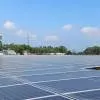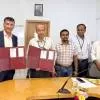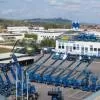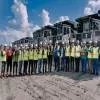- Home
- Real Estate
- Roofing: Top Stuff
Roofing: Top Stuff
Roofing technologies have come of age, facilitating the construction of myriad well-crowned buildings.
The roof is no longer just an appendage of a building; many a time, it is its crowning glory. Thus, it is no surprise that roofing technologies have metamorphosed in recent years. The latest roofing products successfully combine aesthetics, novelty, performance and sustainability to help designers stretch the boundaries of their imagination and develop stunning forms. Nowadays, the bevy of overseas and Indian companies jostling each other for a greater share of the roofing market pie are equally focused on putting out customised products specially designed for Indian conditions.
Materials galore
According to Suresh K Pillai, Business Head - India, Corus India Pvt Ltd (Kalzip Division), "Aluminium is certainly the ideal choice of material for metal buildings, owing to its inherent non-corrosive properties in extreme conditions found in many parts of India. That aluminium can be recycled 100 per cent and has scrap value, makes it logical for builders and architects to promote this environment-friendly material. When combined with its build ability and Kalzip's clip lock system, it is possible to achieve all functional parameters for a roof, combined with great aesthetic sense as may be seen in the Eon Panchsheel building in Pune. Kalzip's KZ 65/400 Aluminium Standing Seam System was used on this roof."
"Stainless steel is the most eco-friendly and long-lasting roofing material by far for its ability to be recycled and its 'green' origins (it is 100 per cent recyclable)," says Achal Puri, AGM - Marketing, JSL Architecture Ltd (formerly known as Jindal Architecture Ltd). Puri cites the Koparkhairane railway station near Mumbai, which was given a resin-coated stainless steel roof as many as 20 years ago, and which is still going strong with no loss of appeal and no corrosion. "Possibly, no material meets international standards and lasts as long; the heritage buildings that are still around us, in spite of the ravages of time, pollution and use over our lifetimes, are testimony to this fact," he says. "Stainless steel has a timeless appeal and is well suited to commercial applications like stations, termini and entrance canopies, as well as false ceilings and trellis in lobby areas. PVR in Waves Mall, Mulund is a case in point. Stainless steel, nowadays, also comes in a mirror finish, in various colour options and may be etched on as well. The present impetus on enhancing the country's infrastructure is bound to create more opportunities for JSL Architecture, which offers total roofing solutions bac-ked by high-end fabrication equipment for welding and polishing to the desired effect."
Catering to the climate
The prime concern in Indian climatic conditions is protecting the internal environment from heat generation (vis-à-vis retaining heat in colder climates), maintains Rahul Chopra, Vice-President - Marketing, Everest Industries. "Still, different kinds of buildings have different requirements (see box). Fortunately, Everest offers a range of products to suit different requirements. For instance, we propose environment-friendly, cement-based products like Everest AC roofing or Everest Hi-Tech for highly corrosive environments as they work better in such conditions than Everest metal roofing solutions, while also taking care of aesthetics. Everest Hi-Tech's cement base is reinforced with synthetic manmade fibres to withstand wear and tear in corrosive and highly humid environments."
Appropriate products are also being mixed and matched to suit project requirements. For instance, a 6,000 sq m (main building measured 87 m × 47 m × 28.5 m) bauxite export unit in Roziport, Jamnagar (Gujarat), was required to resist high wind velocity, be leak-proof, consume no power during the day and be built of non-corrosive material as the project is virtually on the sea. These individual needs were met by reducing purlin spacing to 1,500 mm and installing it at a slope of 22°, installing an end lap of 250 mm, using Everest Rooflights on the monitor roof and using silicon-modified polyester (SMP) coated Galvalume (AZ-150, 550 Mpa). The cladding of Everest Rooflights combined well with the metal sheeting. These high-quality polycarbonate roofing sheets function as daylight panels, allowing natural light into the space and bringing down energy costs. The design and installation of the metal sheets at an angle of 22° was critical but mandatory to meet the specifications laid out by consultant and architect Modarch Consultants, Kochi. Metal sheeting was also used for additional buildings like the shade, office complex, generator room and guard room. In all, sheets costing about Rs 32 lakh were used.
Roofing shingles
A visible trend in cities includes the increasing use of roofing shingles; that is, roof coverings consisting of typically flat, rectangular, individual overlapping elements. To cite an example, Saint CertainTeed roofing shingles from Saint Gobain are made of fibreglass-reinforced, high-grade, mineral-stabilised, asphalt-based mats overlaid with high-strength, ceramic-coated granules and underlaid with a mineral stabiliser-cum-fire retardant. The product has been well received by the market.
"Shingles offer significant advantages that have led to their growing popularity in India vis-à-vis conventional roofing systems," says Harish V Holalu, Senior Manager, Building Products & Solutions, Saint-Gobain, Grindwell Norton Ltd. "They are a default choice for roofing in the US and European markets; it is estimated that nine out of 10 roofs in the US are covered by shingles. We have installed more than 50 lakh sq ft of shingles so far, in prestigious projects such as Lavasa, Amby Valley, Sobha Adamus in Bengaluru, etc."
Roofing shingles are especially well-suited to upmarket, gated residential complexes. IDEB's Springville in Bengaluru, a gated community with over 50 row houses, makes use of CertainTeed Firehalt roofing shingles in driftwood shade over an area of 90,000 sq ft. CertainTeed was selected for its superior aesthetics stemming from its innovative multi-laminate pattern profiles and its easy application and technical advantages. The latter include zero-maintenance, durability, breakage, algae, wind and temperature resistance, the fact that it is impact and fire proof and its ability to be applied on wooden and concrete decks. "Saint CertainTeed roofing shingles have an edge over clay or concrete tiles as the application overlap of over 50 per cent renders the product completely waterproof," adds Holulu. "They also carry an attractive product warranty of 25 years to a lifetime and are easier to apply on very steep slopes of over 45°."
Saint Gobain offers its Indian clients additional services like site supervision, quality inspection and design and drawing support. In a bid to customise the product for the Indian market, where most roofs are made of concrete, unlike in western countries where they use wood, Saint Gobain has also specifically identified fasteners, flashing strips and liquid primers to aid the application of shingles on concrete.
Polycarbonate sheets
Shopping malls coming up in cities across the country are paving the way for the greater use of transparent, tinted and coloured polycarbonate sheets. Gallina, a JV of Coxwell Domes Engineers Ltd and Dott Gallina Srl of Italy, has also supplied its patented ArcoPlus polycarbonate sheets for the MMRDA's Mumbai skywalks and for stadium and residential projects. Ram Avtar Sharma, Director, Gallina, maintains that the uptake of this product is likely to increase in the near future, as its dual-side UV protection gives it longevity, while its modular system makes it virtually leak-proof. To add to that, the product is cost-efficient, resists bending, is watertight and resists wind pressure and fire. Its patented Multicell structure transmits light evenly throughout the panels and gives the product high thermal insulation value.
Although polycarbonate sheets are being imported into India, Sharma believes the India-based manufacturer Gallina has an edge over competitors as it is not limited to 40 ft lengths that can be imported in 40 ft containers. "We have supplied customers up to 82 ft lengths of 600 mm width," he adds. "Having a local manufacturing base allows us to take on customised orders and start jobs immediately. We also help our clients save customs duties applicable on imported sheets."
Standing seam technology
Appropriate roofing (and side wall) systems allow the building envelope to be designed to meet desirable performance parameters. At Karlovy Vary International Airport at the Czech Republic border with Germany, Kalzip's Aluminium KZ 65/400 standing seam system with acoustic insulation optimises HVAC loads by achieving the desired thermal insulation conceived by designers and helps block out aircraft noise. The product thus enhances comfort levels within the terminal.
Standing seam roof (SSR) technology is well suited to pitched roofs where the roof is free of penetrations (such as roof platforms, pipes, roof vents). MaxSeam roof system from Zamil Steel offers a 76 mm high standing seam that is well above the water level flowing down the roof. In addition, the factory-applied sealant inside the seams ensures total tightness. MaxSeam panels can also be made to support solar panel installations on the roof if the specifications are provided in advance. An installation in Karnataka makes use of continuous 93 m long MaxSeam panels roll-formed at site; the panels act as a monolithic membrane that helps curtail water ingress. These roof panels can be applied on roofs as wide as 100 m without any end laps and weather-tight 360° seams along the side laps.
Innovative additions to SSR technology are also useful to circumvent the problem of thermal movement, a concern in pre-engineered metal buildings. MaxSeam panels, for instance, boast a fastening system designed to eliminate the potentially damaging effects of thermal movement. Special ArtiFloat clips concealed inside the raised seam lock the panels in place. These unique clips have a moveable feature allowing the panel to expand and contract with temperature changes, i.e., giving the roof surface a floating action. The concealed clip system minimises through-roof fasteners, thus greatly reducing the chances of leaks. Zamil Steel MaxSeam panels are accredited by FM Global, one of the highest quality-assurance certifications of fire rating.
Standing seam technology also applies to polycarbonate panels. "ArcoPlus polycarbonate panels come with vertical standing seam on both sides, fastened to existing structures via a purpose-built aluminium cleat," says Sharma. "Panels are assembled between the cleats using a polycarbonate click-on connector system."
Roof ventilation
Ventilation is an important aspect of roofing. Adequate ventilation extends the life of a roof and helps maintain ambient indoor conditions, critical for the comfort of occupants and to avoid sick building syndrome. In manufacturing setups, the ventilation system can also facilitate the production process. But, ventilation needs differ from one building to the next. "No two industries are the same," says Dinesh Jaikumar, Director - Projects, SunGreen Ventilation Systems Pvt Ltd. "Manufacturing is starkly different from, say the pharma industry, and even two pharma units may have differing ventilation requirements. Factors such as the process, number of occupants, geographical location of the unit, openings provided, layout, interior décor (false ceiling included or not) and so on extensively contribute to the conditions existing inside a building. All these aspects must be considered at the outset, when designing the structure and its ventilation system to provide an economical and engineered building system. That is why we offer GreenCurve Roofing Systems – curved systems with no nuts/bolts/trusses and a host of ventilation equipment, all of which are customised to suit the needs of each client and provide a comprehensive building solution at the time of construction itself."
For instance, SunGreen's treatment of a food processing unit involved creating a 100 per cent, leak-proof roofing system with a precise turbovent ventilation system to ensure that conditions inside the building and the air quality meet stringent norms. A battery manufacturing plant replete with furnaces, acid baths and harmful poisonous lead particles floating in the air was given a specially designed ventilation system. "Ventilation engineers must understand every aspect of the production process as an inappropriate ventilation system could be more harmful than no system," adds Jaikumar. "We analysed conditions using appropriate data based on international standards (ASHRAE, ACGIH) and provided our client with an engineered system designed to take care of the emission volume and route of harmful fumes and other gases."
Strategically placed turbovents were used for both these installations as it is a vital part of a general ventilation system and a zero-maintenance and zero-operational cost component. Turbovents run on wind energy and other factors (no electricity); hence they are highly efficient and long-lasting.
Cool roofs
Cool roof denotes the property of the roof to reflect and emit (reject heat back into the environment) heat. Building on this, the primary aim of cool roof technology is to reduce the amount of energy absorbed by the roof surface by meeting a minimum solar reflectance of 0.7. As the New Delhi-based International Resources Group team that is implementing the USAID-funded ECO-III project (a bilateral project between the Government of India and the US Government aimed at the commercialising of energy efficiency in India) explains in its report – An Introduction to Cool Roof – "Visual colouring plays a significant role in this as dark surfaces typically warm the area over buildings leading to the creation of energy guzzling urban 'heat islands'. In contrast, solar reflective light-coloured surfaces absorb less sunlight and lower air-conditioning loads. Interestingly, light-coloured roofing (and exterior walls) surfaces are a time-honoured technique of staying cool in the Mediterranean, Caribbean, and other sun-drenched locales."
"The magnitude of energy savings delivered by a well-designed cool roof depends on the building type, level of roof insulation, ventilation rate between roof and ceiling, air-conditioning size and efficiency, and roof solar reflectance," continues the report. Cool roof technologies include coatings, membranes, tiles and shingles. Roofing materials with high reflectance, or high albedo, can reflect up to 85 per cent of incident solar radiation compared to normal surfaces that may reflect only 20 per cent (dark roofs can be as low as 5 per cent). For commercial applications, flat, poorly insulated roofs are the best candidates for high albedo materials.
The increasing use of metal roofing sheets also brings their heat emissivity property under the scanner as an important factor to consider in cooling load reduction. "Although many metals have a high solar reflectance, if emissivity is low, the material will not reject heat effectively," observes the ECO-III project team. The best performing roofing materials for cooling load reduction have both high albedo and high emissivity. Treating roofs (and walls) with light-coloured paints and special compounds made for the purpose helps in this regard by increasing reflectance to the desirable 70 per cent.
For instance, the report states that a USAID-sponsored study taken up at Satyam Technology Centre in Hyderabad showed that installing a white roof coating from Thermoshield (USA) reduced the average summertime daily maximum roof-surface temperature of a two-storey office building by 20°, from 52° to 32°. The total air-conditioning use was correspondingly lowered by 30 kwh/day (5 per cent on hot days and 8 per cent on other days). Cool roofs thus ensure significantly more comfortable interiors, and when coupled with other measures such as introducing urban vegetation and cool pavements, they also help mitigate the urban 'heat island' effect. In Hyderabad, maximum temperature reduction of up to 2.5° C and 3.5° C were noted.
Green roofs
Modern urban areas are known to suffer from a paucity of vegetation, a lacuna that is increasingly being addressed by the creation of green roofs. Green roofs, or vegetative layers grown on rooftops, can serve as scenic roof gardens or as protected habitats for flora and fauna in city centres. They may be categorised as extensive, semi-intensive or intensive depending on the purpose they serve, the load they put on the roofing structure, their plant selection, maintenance and irrigation needs, the depth of the substrate and cost. Lower-cost, extensive green roofs are better suited to roofs with less load-bearing capacity and planned to be used to grow low-maintenance, sun, wind and drought-tolerant plant varieties. At the other end of the spectrum are intensive green roofs, intended to be used as rooftop gardens and hence boasting of lawns, perennials, bushes and trees (see box). Additional features like walkways, benches, playgrounds and ponds can be created on intensive green roofs.
As Madhup Mazumder, Principal Landscape Architect, Design Accord explains, "You need a good drainage system (Danodrain or gravel layer + geotextile) facilitated by a legitimate slope on a finished roof deck slab, well drained soil of at least 250 mm for grassing, 600 mm for shrubs and 1,000 to 1,200 mm depth soil for trees and palm. Obviously, the load consideration of wet soil and plants has to be factored in beforehand, during the structural design."
A host of products are helping create novel green roofs. Mazumder used Danodrain boards and grass cell structures to create shallow (8 inch) soil planting beds (extensive green roof) on the metal decking of the stand-out 85 m long, 15 m wide canopy floating over the wide drive-in plaza of Technopolis – an IT Park developed by Phoenix Software as Kolkata's first green building (Gold-rated) project. As the driveway is also a slab on the basement level, the same system was used to create planting beds on the ground level. "The metal canopy, in conforming to a mandatory requirement of every green building to convert its exposed deck top to green areas to reduce the 'heat island' effect of a built complex, also enhances the view from the up-per storeys of the building as well as maximises the green potential of the first floor area," he adds. "Products from ZTC International and Acodrain are useful green roof systems."
Thanks to the extensive range of roofing products on offer, now, more buildings than ever can be expected to make impressive statements – even from afar.
- Construction
- Update
- Portal
- Magazine
- CW-India
- June
- 2011
- India
- Roofing
- technologies
- sustainability
- Suresh K Pillai
- Corus India Pvt Ltd
- Aluminium Standing Seam System
- Pune
- eco-friendly
- Achal Puri
- Stainless steel
- infrastructure
- JSL Architecture
- Everest AC roofing
- Everest Rooflights
- SMP
- Kochi
- Saint Gobain
- Saint CertainTeed
- Harish V Holalu
- IDEB
- polycarbonate sheets
- MMRDA
- Gallina
- HVAC
- MaxSeam roof
- SSR technology
- Ventilation
- GreenCurve Roofing Systems
- New Delhi
- USAID
- Hyderabad
- Madhup Mazumder
- Danodrain boards
- Satyam Technology Centre
Roofing technologies have come of age, facilitating the construction of myriad well-crowned buildings. The roof is no longer just an appendage of a building; many a time, it is its crowning glory. Thus, it is no surprise that roofing technologies have metamorphosed in recent years. The latest roofing products successfully combine aesthetics, novelty, performance and sustainability to help designers stretch the boundaries of their imagination and develop stunning forms. Nowadays, the bevy of overseas and Indian companies jostling each other for a greater share of the roofing market pie are equally focused on putting out customised products specially designed for Indian conditions. Materials galore According to Suresh K Pillai, Business Head - India, Corus India Pvt Ltd (Kalzip Division), Aluminium is certainly the ideal choice of material for metal buildings, owing to its inherent non-corrosive properties in extreme conditions found in many parts of India. That aluminium can be recycled 100 per cent and has scrap value, makes it logical for builders and architects to promote this environment-friendly material. When combined with its build ability and Kalzip's clip lock system, it is possible to achieve all functional parameters for a roof, combined with great aesthetic sense as may be seen in the Eon Panchsheel building in Pune. Kalzip's KZ 65/400 Aluminium Standing Seam System was used on this roof. Stainless steel is the most eco-friendly and long-lasting roofing material by far for its ability to be recycled and its 'green' origins (it is 100 per cent recyclable), says Achal Puri, AGM - Marketing, JSL Architecture Ltd (formerly known as Jindal Architecture Ltd). Puri cites the Koparkhairane railway station near Mumbai, which was given a resin-coated stainless steel roof as many as 20 years ago, and which is still going strong with no loss of appeal and no corrosion. Possibly, no material meets international standards and lasts as long; the heritage buildings that are still around us, in spite of the ravages of time, pollution and use over our lifetimes, are testimony to this fact, he says. Stainless steel has a timeless appeal and is well suited to commercial applications like stations, termini and entrance canopies, as well as false ceilings and trellis in lobby areas. PVR in Waves Mall, Mulund is a case in point. Stainless steel, nowadays, also comes in a mirror finish, in various colour options and may be etched on as well. The present impetus on enhancing the country's infrastructure is bound to create more opportunities for JSL Architecture, which offers total roofing solutions bac-ked by high-end fabrication equipment for welding and polishing to the desired effect. Catering to the climate The prime concern in Indian climatic conditions is protecting the internal environment from heat generation (vis-à-vis retaining heat in colder climates), maintains Rahul Chopra, Vice-President - Marketing, Everest Industries. Still, different kinds of buildings have different requirements (see box). Fortunately, Everest offers a range of products to suit different requirements. For instance, we propose environment-friendly, cement-based products like Everest AC roofing or Everest Hi-Tech for highly corrosive environments as they work better in such conditions than Everest metal roofing solutions, while also taking care of aesthetics. Everest Hi-Tech's cement base is reinforced with synthetic manmade fibres to withstand wear and tear in corrosive and highly humid environments. Appropriate products are also being mixed and matched to suit project requirements. For instance, a 6,000 sq m (main building measured 87 m × 47 m × 28.5 m) bauxite export unit in Roziport, Jamnagar (Gujarat), was required to resist high wind velocity, be leak-proof, consume no power during the day and be built of non-corrosive material as the project is virtually on the sea. These individual needs were met by reducing purlin spacing to 1,500 mm and installing it at a slope of 22°, installing an end lap of 250 mm, using Everest Rooflights on the monitor roof and using silicon-modified polyester (SMP) coated Galvalume (AZ-150, 550 Mpa). The cladding of Everest Rooflights combined well with the metal sheeting. These high-quality polycarbonate roofing sheets function as daylight panels, allowing natural light into the space and bringing down energy costs. The design and installation of the metal sheets at an angle of 22° was critical but mandatory to meet the specifications laid out by consultant and architect Modarch Consultants, Kochi. Metal sheeting was also used for additional buildings like the shade, office complex, generator room and guard room. In all, sheets costing about Rs 32 lakh were used. Roofing shingles A visible trend in cities includes the increasing use of roofing shingles; that is, roof coverings consisting of typically flat, rectangular, individual overlapping elements. To cite an example, Saint CertainTeed roofing shingles from Saint Gobain are made of fibreglass-reinforced, high-grade, mineral-stabilised, asphalt-based mats overlaid with high-strength, ceramic-coated granules and underlaid with a mineral stabiliser-cum-fire retardant. The product has been well received by the market. Shingles offer significant advantages that have led to their growing popularity in India vis-à-vis conventional roofing systems, says Harish V Holalu, Senior Manager, Building Products & Solutions, Saint-Gobain, Grindwell Norton Ltd. They are a default choice for roofing in the US and European markets; it is estimated that nine out of 10 roofs in the US are covered by shingles. We have installed more than 50 lakh sq ft of shingles so far, in prestigious projects such as Lavasa, Amby Valley, Sobha Adamus in Bengaluru, etc. Roofing shingles are especially well-suited to upmarket, gated residential complexes. IDEB's Springville in Bengaluru, a gated community with over 50 row houses, makes use of CertainTeed Firehalt roofing shingles in driftwood shade over an area of 90,000 sq ft. CertainTeed was selected for its superior aesthetics stemming from its innovative multi-laminate pattern profiles and its easy application and technical advantages. The latter include zero-maintenance, durability, breakage, algae, wind and temperature resistance, the fact that it is impact and fire proof and its ability to be applied on wooden and concrete decks. Saint CertainTeed roofing shingles have an edge over clay or concrete tiles as the application overlap of over 50 per cent renders the product completely waterproof, adds Holulu. They also carry an attractive product warranty of 25 years to a lifetime and are easier to apply on very steep slopes of over 45°. Saint Gobain offers its Indian clients additional services like site supervision, quality inspection and design and drawing support. In a bid to customise the product for the Indian market, where most roofs are made of concrete, unlike in western countries where they use wood, Saint Gobain has also specifically identified fasteners, flashing strips and liquid primers to aid the application of shingles on concrete. Polycarbonate sheets Shopping malls coming up in cities across the country are paving the way for the greater use of transparent, tinted and coloured polycarbonate sheets. Gallina, a JV of Coxwell Domes Engineers Ltd and Dott Gallina Srl of Italy, has also supplied its patented ArcoPlus polycarbonate sheets for the MMRDA's Mumbai skywalks and for stadium and residential projects. Ram Avtar Sharma, Director, Gallina, maintains that the uptake of this product is likely to increase in the near future, as its dual-side UV protection gives it longevity, while its modular system makes it virtually leak-proof. To add to that, the product is cost-efficient, resists bending, is watertight and resists wind pressure and fire. Its patented Multicell structure transmits light evenly throughout the panels and gives the product high thermal insulation value. Although polycarbonate sheets are being imported into India, Sharma believes the India-based manufacturer Gallina has an edge over competitors as it is not limited to 40 ft lengths that can be imported in 40 ft containers. We have supplied customers up to 82 ft lengths of 600 mm width, he adds. Having a local manufacturing base allows us to take on customised orders and start jobs immediately. We also help our clients save customs duties applicable on imported sheets. Standing seam technology Appropriate roofing (and side wall) systems allow the building envelope to be designed to meet desirable performance parameters. At Karlovy Vary International Airport at the Czech Republic border with Germany, Kalzip's Aluminium KZ 65/400 standing seam system with acoustic insulation optimises HVAC loads by achieving the desired thermal insulation conceived by designers and helps block out aircraft noise. The product thus enhances comfort levels within the terminal. Standing seam roof (SSR) technology is well suited to pitched roofs where the roof is free of penetrations (such as roof platforms, pipes, roof vents). MaxSeam roof system from Zamil Steel offers a 76 mm high standing seam that is well above the water level flowing down the roof. In addition, the factory-applied sealant inside the seams ensures total tightness. MaxSeam panels can also be made to support solar panel installations on the roof if the specifications are provided in advance. An installation in Karnataka makes use of continuous 93 m long MaxSeam panels roll-formed at site; the panels act as a monolithic membrane that helps curtail water ingress. These roof panels can be applied on roofs as wide as 100 m without any end laps and weather-tight 360° seams along the side laps. Innovative additions to SSR technology are also useful to circumvent the problem of thermal movement, a concern in pre-engineered metal buildings. MaxSeam panels, for instance, boast a fastening system designed to eliminate the potentially damaging effects of thermal movement. Special ArtiFloat clips concealed inside the raised seam lock the panels in place. These unique clips have a moveable feature allowing the panel to expand and contract with temperature changes, i.e., giving the roof surface a floating action. The concealed clip system minimises through-roof fasteners, thus greatly reducing the chances of leaks. Zamil Steel MaxSeam panels are accredited by FM Global, one of the highest quality-assurance certifications of fire rating. Standing seam technology also applies to polycarbonate panels. ArcoPlus polycarbonate panels come with vertical standing seam on both sides, fastened to existing structures via a purpose-built aluminium cleat, says Sharma. Panels are assembled between the cleats using a polycarbonate click-on connector system. Roof ventilation Ventilation is an important aspect of roofing. Adequate ventilation extends the life of a roof and helps maintain ambient indoor conditions, critical for the comfort of occupants and to avoid sick building syndrome. In manufacturing setups, the ventilation system can also facilitate the production process. But, ventilation needs differ from one building to the next. No two industries are the same, says Dinesh Jaikumar, Director - Projects, SunGreen Ventilation Systems Pvt Ltd. Manufacturing is starkly different from, say the pharma industry, and even two pharma units may have differing ventilation requirements. Factors such as the process, number of occupants, geographical location of the unit, openings provided, layout, interior décor (false ceiling included or not) and so on extensively contribute to the conditions existing inside a building. All these aspects must be considered at the outset, when designing the structure and its ventilation system to provide an economical and engineered building system. That is why we offer GreenCurve Roofing Systems – curved systems with no nuts/bolts/trusses and a host of ventilation equipment, all of which are customised to suit the needs of each client and provide a comprehensive building solution at the time of construction itself. For instance, SunGreen's treatment of a food processing unit involved creating a 100 per cent, leak-proof roofing system with a precise turbovent ventilation system to ensure that conditions inside the building and the air quality meet stringent norms. A battery manufacturing plant replete with furnaces, acid baths and harmful poisonous lead particles floating in the air was given a specially designed ventilation system. Ventilation engineers must understand every aspect of the production process as an inappropriate ventilation system could be more harmful than no system, adds Jaikumar. We analysed conditions using appropriate data based on international standards (ASHRAE, ACGIH) and provided our client with an engineered system designed to take care of the emission volume and route of harmful fumes and other gases. Strategically placed turbovents were used for both these installations as it is a vital part of a general ventilation system and a zero-maintenance and zero-operational cost component. Turbovents run on wind energy and other factors (no electricity); hence they are highly efficient and long-lasting. Cool roofs Cool roof denotes the property of the roof to reflect and emit (reject heat back into the environment) heat. Building on this, the primary aim of cool roof technology is to reduce the amount of energy absorbed by the roof surface by meeting a minimum solar reflectance of 0.7. As the New Delhi-based International Resources Group team that is implementing the USAID-funded ECO-III project (a bilateral project between the Government of India and the US Government aimed at the commercialising of energy efficiency in India) explains in its report – An Introduction to Cool Roof – Visual colouring plays a significant role in this as dark surfaces typically warm the area over buildings leading to the creation of energy guzzling urban 'heat islands'. In contrast, solar reflective light-coloured surfaces absorb less sunlight and lower air-conditioning loads. Interestingly, light-coloured roofing (and exterior walls) surfaces are a time-honoured technique of staying cool in the Mediterranean, Caribbean, and other sun-drenched locales. The magnitude of energy savings delivered by a well-designed cool roof depends on the building type, level of roof insulation, ventilation rate between roof and ceiling, air-conditioning size and efficiency, and roof solar reflectance, continues the report. Cool roof technologies include coatings, membranes, tiles and shingles. Roofing materials with high reflectance, or high albedo, can reflect up to 85 per cent of incident solar radiation compared to normal surfaces that may reflect only 20 per cent (dark roofs can be as low as 5 per cent). For commercial applications, flat, poorly insulated roofs are the best candidates for high albedo materials. The increasing use of metal roofing sheets also brings their heat emissivity property under the scanner as an important factor to consider in cooling load reduction. Although many metals have a high solar reflectance, if emissivity is low, the material will not reject heat effectively, observes the ECO-III project team. The best performing roofing materials for cooling load reduction have both high albedo and high emissivity. Treating roofs (and walls) with light-coloured paints and special compounds made for the purpose helps in this regard by increasing reflectance to the desirable 70 per cent. For instance, the report states that a USAID-sponsored study taken up at Satyam Technology Centre in Hyderabad showed that installing a white roof coating from Thermoshield (USA) reduced the average summertime daily maximum roof-surface temperature of a two-storey office building by 20°, from 52° to 32°. The total air-conditioning use was correspondingly lowered by 30 kwh/day (5 per cent on hot days and 8 per cent on other days). Cool roofs thus ensure significantly more comfortable interiors, and when coupled with other measures such as introducing urban vegetation and cool pavements, they also help mitigate the urban 'heat island' effect. In Hyderabad, maximum temperature reduction of up to 2.5° C and 3.5° C were noted. Green roofs Modern urban areas are known to suffer from a paucity of vegetation, a lacuna that is increasingly being addressed by the creation of green roofs. Green roofs, or vegetative layers grown on rooftops, can serve as scenic roof gardens or as protected habitats for flora and fauna in city centres. They may be categorised as extensive, semi-intensive or intensive depending on the purpose they serve, the load they put on the roofing structure, their plant selection, maintenance and irrigation needs, the depth of the substrate and cost. Lower-cost, extensive green roofs are better suited to roofs with less load-bearing capacity and planned to be used to grow low-maintenance, sun, wind and drought-tolerant plant varieties. At the other end of the spectrum are intensive green roofs, intended to be used as rooftop gardens and hence boasting of lawns, perennials, bushes and trees (see box). Additional features like walkways, benches, playgrounds and ponds can be created on intensive green roofs. As Madhup Mazumder, Principal Landscape Architect, Design Accord explains, You need a good drainage system (Danodrain or gravel layer + geotextile) facilitated by a legitimate slope on a finished roof deck slab, well drained soil of at least 250 mm for grassing, 600 mm for shrubs and 1,000 to 1,200 mm depth soil for trees and palm. Obviously, the load consideration of wet soil and plants has to be factored in beforehand, during the structural design. A host of products are helping create novel green roofs. Mazumder used Danodrain boards and grass cell structures to create shallow (8 inch) soil planting beds (extensive green roof) on the metal decking of the stand-out 85 m long, 15 m wide canopy floating over the wide drive-in plaza of Technopolis – an IT Park developed by Phoenix Software as Kolkata's first green building (Gold-rated) project. As the driveway is also a slab on the basement level, the same system was used to create planting beds on the ground level. The metal canopy, in conforming to a mandatory requirement of every green building to convert its exposed deck top to green areas to reduce the 'heat island' effect of a built complex, also enhances the view from the up-per storeys of the building as well as maximises the green potential of the first floor area, he adds. Products from ZTC International and Acodrain are useful green roof systems. Thanks to the extensive range of roofing products on offer, now, more buildings than ever can be expected to make impressive statements – even from afar.
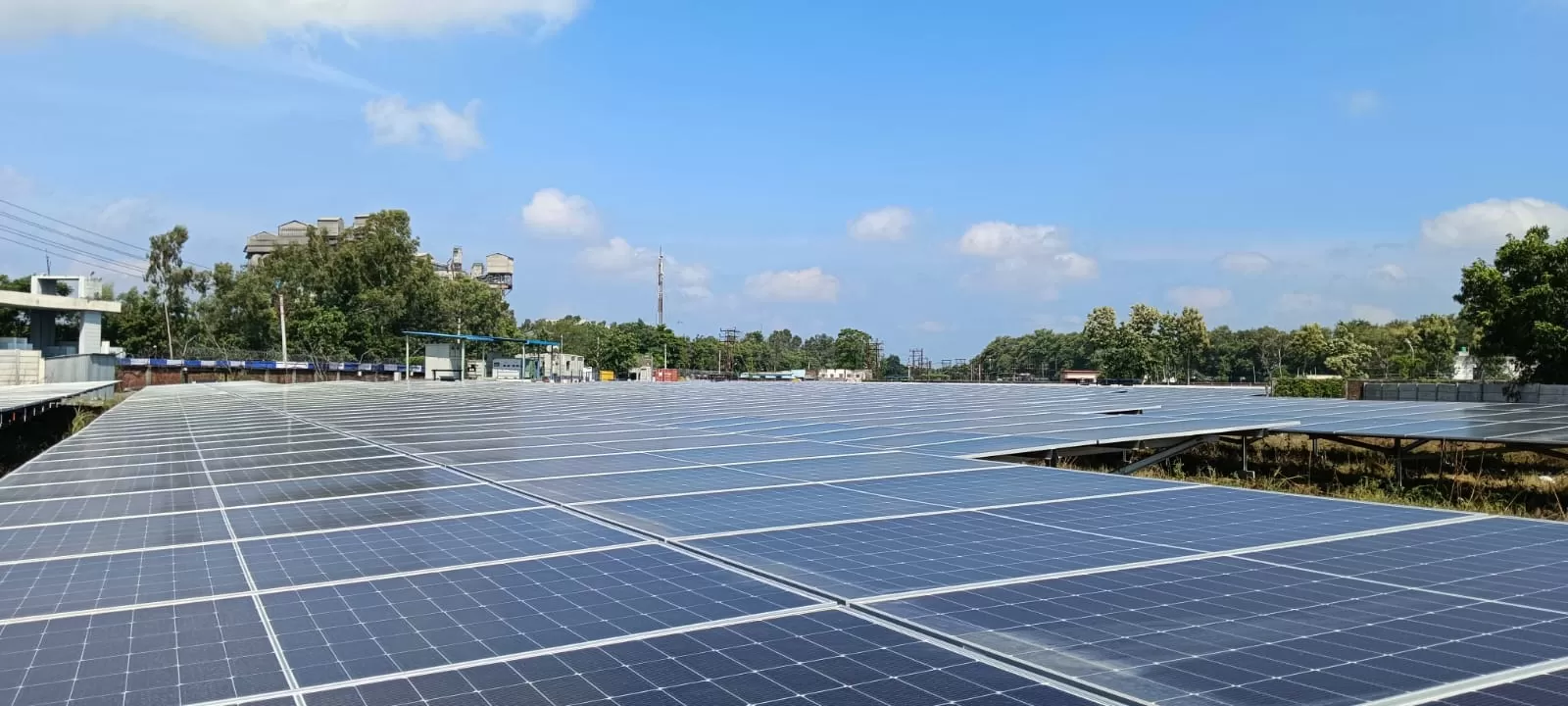
Shree Cement Boosts Green Goals with 6 MW Solar Plant in Roorkee
Shree Cement, one of India’s leading cement producers, has commissioned a 6.0 MWp solar power plant at its Roorkee unit in Uttarakhand. Strategically located next to its existing cement operations, the plant marks a significant step forward in the company’s journey towards its RE100 targets and decarbonization goals.With this latest addition, solar capacity at the Roorkee facility has grown sevenfold from 1.0 MWp to 7.0 MWp. Shree Cement’s total solar footprint now stands at an impressive 293.5 MWp, reinforcing its leadership in sustainable manufacturing within India’s cement sector.Ne..
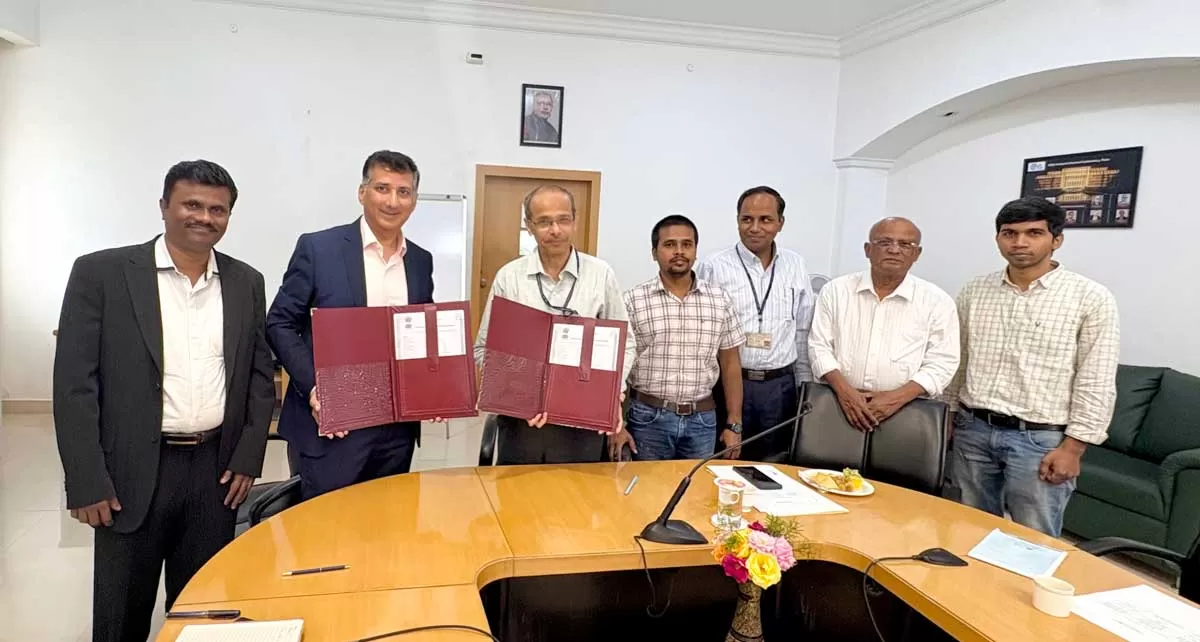
Covestro India, CSIR-NCL Partner to Recycle Polyurethane Waste
Convestro (India) National has signed a Memorandum of Understanding (MOU) with the CSIR- Chemical Laboratory (NCL) launching an innovative Corporate Social Responsibility project aimed at developing sustainable upcycling solutions for polyurethane materials, addressing the critical limitations in current recycling technologies.The collaborative project will explore innovative approaches to transform polyurethane waste into valuable chemical building blocks. This research aims to develop commercially viable technologies that could greatly improve the circularity of polyurethane materials while ..

Aimtron Electronics Raises Rs 1 Bn via Warrants for New Facility
Aimtron Electronics, a fast-growing Electronics System Design and Manufacturing (ESDM) company, hased a fundraise of approximately Rs 1 billion through the issuance of convertible warrants on a preferential basis. The round includes participation from the promoter group including Mukesh Vasani and Nirmal Vasani along with a host of marquee investors.The Board of Directors of Aimtron Electronics has approved the issuance of up to 14,79,000 warrants of the company, at the price of Rs 666 per warrant each convertible into, for one fully paid-up equity share of the company of face value of Rs 10 a..
Latest Updates
Advertisement
Recommended for you
Advertisement
Subscribe to Our Newsletter
Get daily newsletters around different themes from Construction world.
Advertisement
Advertisement
subscribe to the newsletter
Don't miss out on valuable insights and opportunities
to connect with like minded professionals






